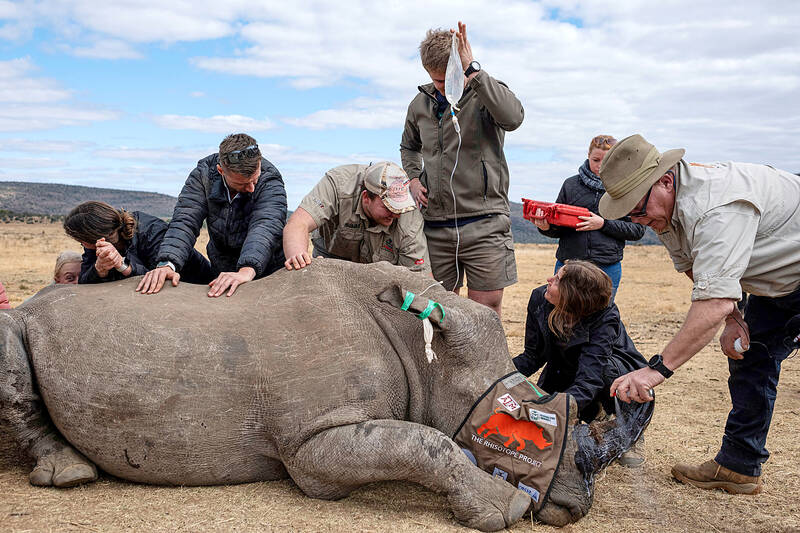South African scientists on Tuesday injected radioactive material into live rhino horns to make them easier to detect at border posts in a pioneering project aimed at curbing poaching.
The country is home to a large majority of the world’s rhinos, and as such, is a hotspot for poaching driven by demand from Asia, where horns are used in traditional medicine for their supposed therapeutic effect.
At the Rhino Orphanage in the Waterberg area of Limpopo province a few of the thick-skinned herbivores grazed in the low savannah.

Photo: AFP
James Larkin, director of the University of the Witwatersrand’s Radiation and Health Physics Unit who spearheaded the initiative, said that he had put “two tiny little radioactive chips in the horn” as he administered the radioisotopes on one of the large animals’ horns.
The radioactive material would “render the horn useless ... essentially poisonous for human consumption” said Nithaya Chetty, dean of the university’s Faculty of Science .
The dusty rhino, put to sleep and crouched on the ground, did not feel any pain, Larkin said.
The radioactive material’s dose was so low it would not affect the animal’s health or the environment in any way, he said.
In February, the South African Department of Environmental Affairs said that, despite government efforts to tackle the illicit trade, 499 of the giant mammals were killed last year, mostly in state-run parks.
This is an 11 percent increase from 2022.
Twenty live rhinos in total would be part of the pilot Rhisotope project, whereby they would be administered a dose “strong enough to set off detectors that are installed globally” at international border posts originally installed “to prevent nuclear terrorism,” Larkin said.
In addition to the thousands of radiation detectors installed at ports and airports, border agents often have handheld radiation detectors that can detect contraband, the scientists said.
Rhino horns are highly sought after on black markets, where the price by weight rivals that of gold and cocaine.
Arrie van Deventer, the orphanage’s founder, said that dehorning the rhino and poisoning the horns has failed to deter poachers.
“Maybe this is the thing that will stop poaching,” Van Deventer said. “This is the best idea I’ve ever heard.”
More than a dozen team members performed the delicate process on another rhino. Larkin meticulously drilled a small hole into the horn, hammered in the radioisotope, then finished off by spraying 11,000 microdots all over the horn.
The last phase of the project would be the animal’s aftercare following “proper scientific protocol and ethical protocol,” project chief operating officer Jessica Babich said.
The team would then take follow-up blood samples to ensure the rhinos are effectively protected.
The material would last five years on the horn, which is cheaper than dehorning every 18 months, Larkin said.
About 15,000 rhinos live in South Africa, the International Rhino Foundation has estimated.

Seven people sustained mostly minor injuries in an airplane fire in South Korea, authorities said yesterday, with local media suggesting the blaze might have been caused by a portable battery stored in the overhead bin. The Air Busan plane, an Airbus A321, was set to fly to Hong Kong from Gimhae International Airport in southeastern Busan, but caught fire in the rear section on Tuesday night, the South Korean Ministry of Land, Infrastructure and Transport said. A total of 169 passengers and seven flight attendants and staff were evacuated down inflatable slides, it said. Authorities initially reported three injuries, but revised the number

A colossal explosion in the sky, unleashing energy hundreds of times greater than the Hiroshima bomb. A blinding flash nearly as bright as the sun. Shockwaves powerful enough to flatten everything for miles. It might sound apocalyptic, but a newly detected asteroid nearly the size of a football field now has a greater than 1 percent chance of colliding with Earth in about eight years. Such an impact has the potential for city-level devastation, depending on where it strikes. Scientists are not panicking yet, but they are watching closely. “At this point, it’s: ‘Let’s pay a lot of attention, let’s

‘BALD-FACED LIE’: The woman is accused of administering non-prescribed drugs to the one-year-old and filmed the toddler’s distress to solicit donations online A social media influencer accused of filming the torture of her baby to gain money allegedly manufactured symptoms causing the toddler to have brain surgery, a magistrate has heard. The 34-year-old Queensland woman is charged with torturing an infant and posting videos of the little girl online to build a social media following and solicit donations. A decision on her bail application in a Brisbane court was yesterday postponed after the magistrate opted to take more time before making a decision in an effort “not to be overwhelmed” by the nature of allegations “so offensive to right-thinking people.” The Sunshine Coast woman —

CHEER ON: Students were greeted by citizens who honked their car horns or offered them food and drinks, while taxi drivers said they would give marchers a lift home Hundreds of students protesting graft they blame for 15 deaths in a building collapse on Friday marched through Serbia to the northern city of Novi Sad, where they plan to block three Danube River bridges this weekend. They received a hero’s welcome from fellow students and thousands of local residents in Novi Said after arriving on foot in their two-day, 80km journey from Belgrade. A small red carpet was placed on one of the bridges across the Danube that the students crossed as they entered the city. The bridge blockade planned for yesterday is to mark three months since a huge concrete construction